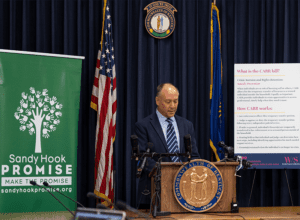The Sandy Hook Promise Action Fund leads state-level efforts to ensure students are not required to participate in active shooter simulations as part of their school safety exercises. The team is prioritizing this issue because of an ongoing trend. Some policy makers are treating active shooter drills and active shooter simulations as one and the same. And that’s putting children at risk.
After the tragedy at Sandy Hook Elementary School, many concerned people set out to prevent that same horror from happening again. Some have tried increasing physical security with metal detectors and barriers. Some have taken a holistic, preventive approach. For example, many now use our programs to prevent gun violence and other harmful acts in schools. Others have used active shooter drills, causing concern among students and parents. In fact, according to experts, their effectiveness remains unclear.
Active Shooter Simulations Are Not Like Fire Drills
Now, a dangerous trend is making active shooter drills more traumatizing than helpful. And this trend could make its way into State Houses across our nation.
Without a doubt, many of us might think active shooter drills are like fire drills. They should help educate and train students on how to take a crisis seriously. Certainly without putting them in harm’s way.
Instead, many of these drills have become live-action simulations of fatal shootings. Rather than empowering students, these simulations can include shooting pellet guns at teachers and spreading fake blood to mimic the scene of a shooting. Sometimes, students aren’t even aware the exercise is just a drill. Moreover, these tactics hurt students and do not help prevent school shootings.
Students already face lockdown, lock-out, or shelter-in-place drills in anticipation of a school shooting. State laws could result in active shooter simulations being added to the list.
Lockdown Drills Are Scary Enough
Active shooter simulations are worse. Many students express anxiety and worry about regular lockdown drills. Generations of students are learning to hide under their desks and barricade their doors. They are taught to block windows to avoid being seen by a potential shooter.
Now, imagine there was someone running through the halls pretending to be a shooter. Imagine them carrying a fake weapon pounding on your student’s classroom door, and taking aim at students and teachers in the hallways. Imagine your local school piping in the sound of gunfire, claiming it will help students prepare for the real thing.
How can we expect students to walk away unscathed?
Help Stop Active Shooter Simulations
Without the right guidance, state legislatures may pass laws that add simulations to the list of approved active shooter exercises. Simulations are not the same as active shooter drills and they must be kept separate. Students should never have to participate in anything that mimics a real-life shooting. We can share that message with our lawmakers.
We recently called on the Texas Education Agency to treat simulations and drills differently. They heard us. This is especially important because in Texas, students are required to participate in active shooter drills.
Minnesota recently passed the Students Safe at School Act to ban mandatory student participation in active shooter simulations. It also makes active shooter drills safer and more supportive for students.
You can help us prevent student trauma in more states. Sign the petition now to help us put a stop to traumatizing active shooter simulations!
Share our Active Shooter Drills and Simulations student toolkit with the young people in your life, recommended for grades 6 and up.


